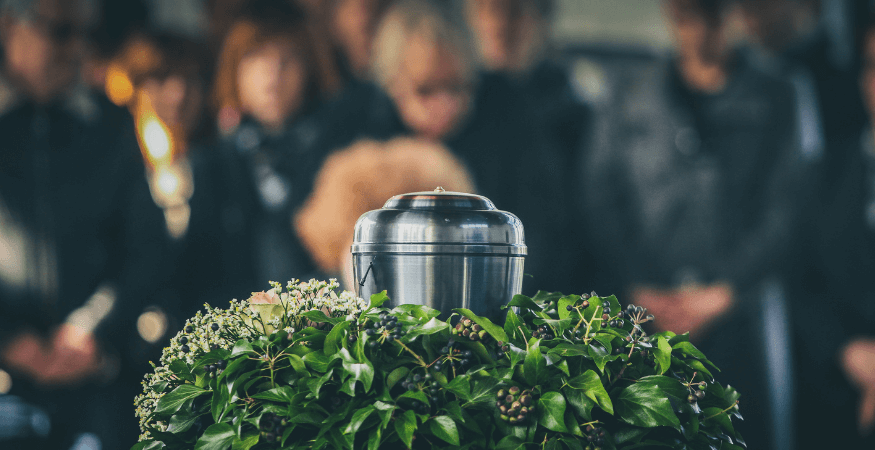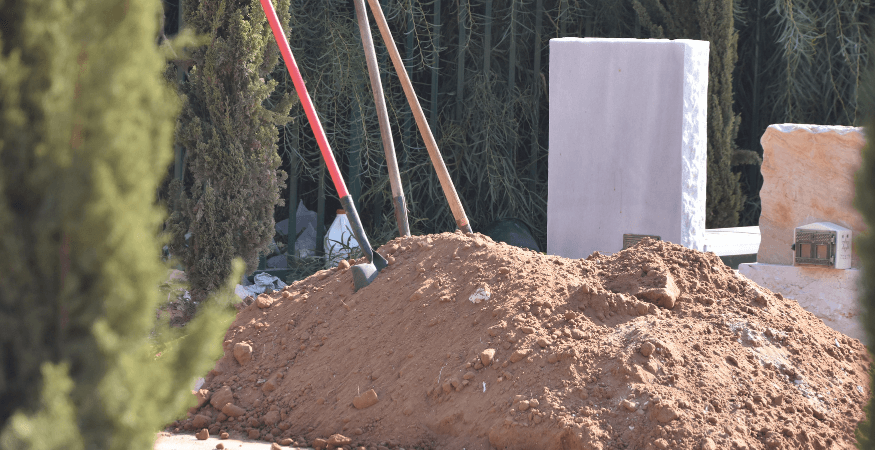Beyond Tradition: Exploring Eco-Friendly Options in Deathcare
We explore the rising trend for green and natural burials, why it's happening and what it means for deathcare providers.
Explore the growing trend of cremation in deathcare, its impact on providers, and the future of memorialisation services.

We're eager to discover more about your cemetery and explore the possibilities of integrating PlotBox seamlessly into your operations.
Let's Talk| Read time: 6 mins
Cremation is on the rise and by looking at some of the factors that have influenced this growth and what that means for deathcare operators of all types, we get a glimpse of where we might be heading.
Cremation is now the most popular method of disposition in the US. The NFDA 2019 Cremation and Burial Report projected a cremation rate of almost 80% by 2040, compared to a burial rate of nearly 16%.
At that time, the cremation rate had outpaced the rate of burial by for the fourth consecutive year, signifying it, according to the NFDA, as no mere trend, rather the ‘new norm’. Moreover, their 2022 report predicted the rate in all US states to exceed 50% by 2035, and the annual number of cremations to rise from 1.91 million in 2022 to 2.94 million in 2040.
Figures from the 2023 CANA Annual Statistics Report shows the rate in the US to be in a state of rapid growth, peaking at around 60% before slowing and plateauing, projecting the rate to reach 65.2% in 2027 vs 59% in 2022.
Figures from The Cremation Society indicate the cremation rate standing at almost 80% in the British Isles in 2021, having seen a steady growth (as with the number of crematories in operation) since first exceeding the number of burials in the late 1960s.[1]
In Australia in 2020, according to figures obtained from the Australian Bureau of Statistics by ACCA, the rate was 65.19%, while in New Zealand that figure rose to 70%. According to the Australian Museum, the cremation rate is rising by half a percent per year.
So why is cremation on the rise and what might that mean for deathcare providers? Let’s look at a number of factors that together may continue to influence these numbers.
Our societal attitudes, beliefs and perceptions are on a continuum - changing, and evolving, reflecting new understandings, dynamics and changing social dynamics.
And so too, we might point to changing cultural attitudes towards death and dying, with taboos or stigmas associated with cremation diminishing. Consider where we are today vs the initial criticisms of cremation in the US, for example, being viewed as a threat to traditional religious burial and ‘society’s sense of morality and dignity’ [2].
We may also consider possible cultural shifts towards emphasising individual autonomy and how that is reflected in personalisation of funeral choices as another factor. With cremation providing a number of options in terms of final deposition, it offers greater choice in aligning funeral choices with personal beliefs, values, and wishes.
And while we might view a general shift towards secularisation being a possible reason for many to eschew traditional burials, opting instead for alternatives that place them in control of the remains [2]; we are also seeing a shift in some religious denominations providing greater flexibility, allowing adherents to choose cremation as a personal preference.
Along with cost, environmental impact, an increasingly transient population [in the US] and changing consumer preferences, the NFDA pointed to a relaxing of traditional religious prohibitions as one of the reasons for the rise. [3] We’ve seen the late 1960s, for example, a greater acceptance within the Roman Catholic church towards cremation practices.
Cost is also cited as a contributing factor in the rise of cremation. Costs vary, but according to the funeral guide, the average cost of cremation in the UK is £934 (not including other funeral costs) vs an average cost of burial of £1,698.
In the US, again, while cost and prices vary by options and states, according to the NFDA, the median cost of a funeral with burial and viewing is around $8k, while with cremation, it is around $7k. Looking at direct cremation - a cremation without service - that number has been estimated at around $1k to $2k.
It's clear then that cremation provides a cost convenience when compared to traditional burial, in potentially eliminating or reducing some expenses associated with burial, and a level of flexibility that is attractive to consumers.

Along with the rising popularity of alternative, ‘green’ forms of burial, our growing eco-awareness and interest in the environment may also be seen as another important factor in the rise of cremation.
We might see this increasing awareness as leading many to consider cremation as a more ecologically sustainable choice of disposition - viewing it as a way to reduce their ecological footprint, conserve resources, and minimise their impact.
Not without its own environmental impact in terms of emissions and energy consumption, cremation largely avoids the use of materials associated with traditional burial, such as caskets made from wood or metal, concrete burial vaults, and headstones.
Similarly it also avoids the use of embalming fluids, reducing the use of formaldehyde or other chemicals that may enter the environment.
Land use and conservation may also factor into people choosing cremation.
In a study by CANA, 13% of people chose cremation because of worries of cemetery land scarcity [2] - where traditional burial requires dedicated cemetery plots, cremation allows remains to be stored in smaller spaces or dispersed in designated areas.
As with burials, the environmental impact of cremation is not insignificant, but by opting for cremation, individuals may believe that they are helping to conserve natural resources and reduce the environmental impact.
We can also look to other factors such as an increased mobility, and changing family structure - with families or individuals becoming increasingly mobile, cremation offers a more flexible option, allowing them to easily transport or keep cremated remains, regardless of their geographical location.
And not forgetting demographic influences and specifically the influence of baby boomers. The aging of the baby boomer generation, known for their individualistic outlook, may also play a significant part, having increasingly embraced cremation as a way to reflect their “evolving end of life preferences.”[3]
Interestingly, we may view the impacts felt, specifically in the US, in the context of a (relatively) recent shift in preferences; as late as 1970, according to some figures, only 5% of Americans chose cremation [2], compared to 59% in 2022.[5]
We might also suggest that this growing demand for cremation has prompted not only crematoria, but cemeteries, and funeral homes to adapt their services, operations, facilities, and approaches in recent times to meet these evolving needs and preferences, while also creating opportunities to innovate, diversify and integrate new technologies.
For crematoria, with increased demand and higher workloads comes a need to adapt operations, modernise and expand. This may include the upgrading of facilities and equipment to increase efficiency and enhance environmental sustainability - investing in advanced cremation equipment, emission control systems, and improved processing capabilities.
From an environmental perspective, that may also involve investigating the introduction of new methods of cremation - such as aquamation (or resomation) also known as - ‘alkaline hydrolysis’; seen as an eco-friendly alternative to traditional cremation, with advocates claiming it uses less energy and produces less emissions.
In terms of operational efficiency, that means the implementation of cloud-based crematorium management systems in order to help schedule and manage cremation appointments, optimise workflows and streamline processes to help reduce turnaround and improve the customer experience.
We may also see further diversification in service provision beyond basic cremation to cater for changing needs and preferences - that may include additional memorialisation options, assistance with scattering or interment of ashes, and the availability of various urn types and keepsakes.
In doing so, crematories can aim to provide a more comprehensive and personalised experience going forward.
For cemeteries, the potential decline in revenue from burial services, coupled with the challenges of space may also provide opportunities in diversifying their services by creating dedicated areas or sections specifically designed for the interment of cremated remains.
These may include vertical structures such as columbaria, or features including scattering gardens, and memorial walls. By offering specialised options for the placement of cremated remains, cemeteries can cater to the needs of cremation families and provide alternative forms of memorialisation.
In a similar vein, where possible, cemeteries might also make landscape and design adaptations, including the integration of scenic gardens, tranquil spaces, or natural areas where families can scatter ashes, or hold memorial services.
And to that point, in embracing environmentally friendly practices, such as the development of green burial sections, cemeteries can also cater to the eco-conscious preferences of cremation families, offering aspects of green or natural burial - such as in the case of hybrid cemeteries.
With attitudes towards technology changing, enhanced memorialisation also provides an opportunity for cemeteries to innovate through the introduction of services such as digital memorials and virtual tributes.
Funeral homes of course continue to play their vital role in providing guidance, support, and meaningful memorialisation options for families, and again, by diversifying their offerings to include online services and personalised memorials that reflect the unique life and preferences of the deceased, for example, they can continue to meet evolving needs and preferences.
In embracing cremation, many funeral homes have expanded their services to include cremation as an in-house offering, investing in equipment, facilities, and trained staff to perform cremations on-site for greater control over the process and a seamless experience for families.
In fact, figures from the NFDA 2022 Cremation and Burial Report shows that nearly half of their members now offer online cremation burial services, as well as a growth in the number of funeral homes owning their own crematories.[6]
The rise of cremation has brought about significant shifts within deathcare, ultimately providing more choice and flexibility in how they approach death and memorialisation.
Influenced in part by changing cultural and religious norms, cost considerations, greater eco-awareness, mobility, and the influence of baby boomers, the rise in cremation has ultimately provided more choice and flexibility in how we approach death and memorialisation.
As deathcare providers continue to evolve and respond to these changing dynamics, they play a vital role in helping individuals and families navigate the journey of honouring and remembering their loved ones.
By embracing innovation, personalised services, environmental sustainability, and community engagement, they can continue to navigate this evolving landscape.
Refs
[1] What percentage of people are buried in the UK?
Baldarroch crematorium
[2] Most Americans today are choosing cremation - here’s why burials are becoming less common
D. Sloane, The Conversation, Jul 22
[3] Cremation is here to stay: Aging baby boomers proved catalyst for in shift beyond traditional burial
NFDA, Jul 19
[4] Cremation is gaining popularity as funeral costs rise
S. Bolling, Forbes, Jan 2023
[5] CANA Industry Statistical Information
[6] Data shows impact OF COVID-19 impact on funeral service is significant
NFDA, Jul 19
Discover how PlotBox Crematory Management Software can help you to manage your teams, improve communication, streamline your processes, and ensure compliance:
We explore the rising trend for green and natural burials, why it's happening and what it means for deathcare providers.
Unleash your inventory's potential. A clear, accurate inventory is the key to growth. Discover how to achieve it and unlock new opportunities.
Green burial best practices for restored scatter beds & organic dispersal innovations.
Be the first to know about our new resources and blogs